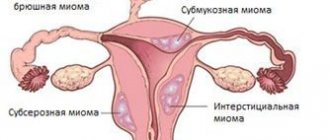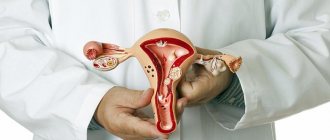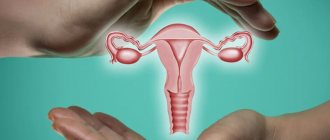Uterine fibroids are one of the most common diseases of the female reproductive system. The risk of becoming a carrier is more than 70%. There are studies that claim that every third woman on earth suffers from this disease at various stages. Fibroids can form at any age, regardless of the number of pregnancies and the presence of other genital diseases, including sexually transmitted diseases.
Every woman should undergo a routine examination by a gynecologist, including assessment of the condition of the vaginal and cervical mucosa, testing (urogenital and vaginal smears) and bimanual examination (manual examination of the cervix, isthmus, appendages and uterus) at least once a year.
Scientists still haven’t fully figured out why fibroids appear. Only one thing is clear, this is a benign tumor that appears and grows thanks to the female hormones estrogen and progesterone. The most surprising thing about this disease is that, unlike many other problems that worsen during the postmenopausal period (doctors say: “after menopause, everything unnecessary grows and health will only get worse”), it has the ability to regress (decrease). Experts attribute this to the same hormones: estrogen and progesterone, the production of which greatly decreases during menopause.
Uterine mass in regression stage
Myoma is detected in the later stages, when the node reaches a large size and clinical symptoms appear. Women complain of menstrual dysfunction, chronic pain in the lower abdomen or lower back, prolonged and heavy bleeding during menstruation, leading to severe anemia. Large fibroids increase the volume of the abdomen, make urination difficult, and lead to a feeling of incomplete emptying of the bladder. Patients report difficulty defecating and constipation. Women's reproductive function is impaired and they cannot become pregnant for a long time.
The next step, after diagnosis, is the choice of treatment method. In this case, the patient wants to avoid surgical treatment and use drug therapy in order to reduce the size of the tumor and bring it into regression.
Uterine fibroids can regress (shrink) not only with the use of special medications, but also for natural reasons.
When tumor regression occurs:
- Menopause period.
- Postmenopause.
- Pregnancy.
- Taking hormonal drugs.
- Use of antitumor drugs in the treatment.
The doctor may consider it necessary to use drug treatment for a patient with fibroids in case of imminent menopause. This will make it possible to convert the drug-induced regression of the tumor into a natural one and avoid surgery.
Uterine fibroids symptoms and signs during menopause
In gynecology, fibroids are understood as a disease of the reproductive system of the female body, as a result of which benign tumor nodes form in the uterine tissues. They can be several millimeters in size, sometimes reaching a larger size - 10 or more centimeters. Uterine fibroids during menopause are recognized as the most common gynecological disease and require mandatory treatment from a specialist. Its danger is obvious - during menopause, the tumor contributes to the exacerbation of other female diseases. Often, in the initial stage, the symptoms of uterine fibroids during menopause do not appear in any way and there are no complaints from patients. This course of the disease is observed in every second case. In the rest, the development of the following symptoms is observed:
- heavy vaginal bleeding of an irregular nature;
- discomfort in the bladder, problems with urination, constipation and pain during bowel movements;
- regular pulling or cutting pain in the lower abdomen and an increase in its size;
- pain during sexual intercourse
Signs and symptoms of uterine fibroids during menopause can be variable and thus misleading.
Reasons for regression of myomatous nodes
Scientists have identified several theories regarding the development of the disease. One of them is hormonal imbalance. In this case, the amount of estrogen, which leads to rapid and pronounced growth of the node, significantly exceeds the level of progesterone. Education is affected by damage to the uterus due to inflammation, curettage, and surgery. At the site of damage, growth hormone is released, which changes hormonal receptors, increasing their consumption of the hormone estrogen. Thus, women with a preserved menstrual cycle are susceptible to the formation of fibroids.
Uterine fibroids during menopause - is surgery necessary?
Surgical intervention (salpingostomy or hysterectomy) is indicated in the absence of positive dynamics of drug treatment. During the operation, all formed nodes are removed. Partial or complete removal of the uterus may be indicated. The surgeon enters through an incision in the abdomen or through the vagina. After the operation, the patient needs some time to recover.
Despite all the biased attitudes towards surgical treatment, in some cases it remains the only way to alleviate a woman’s condition and even save her life. The operation has little effect on the quality of sexual life and allows you to have a full-fledged marital relationship.
Myoma is a disease that requires a professional approach to treatment. Alternative medicine, taking dietary supplements, performing physiological procedures and acupuncture do not always lead to recovery. Self-medication at home can cause even greater complications.
Reasons for tumor regression
One of the main negative factors for the growth of myomatous nodes and the progression of leiomyomas are estrogen hormones. Of the endocrine disorders, the following conditions are important:
- relative hyperestrogenism (normal concentration of estrogen in the blood with a decrease in the amount of progesterone);
- absolute hyperestrogenism (increased amount of estrogens with normal or reduced concentration of gestagens).
In a woman during the reproductive period, any of these factors can provoke the rapid growth of myomatous nodes and the progression of a benign muscle tumor. With a reduced estrogen concentration or a pronounced predominance of gestagen hormones, uterine fibroids will not grow. Blood circulation in the uterine vessels is of great importance: the better the nutrition, the faster and more pronounced the growth of the nodes.
Regression of uterine leiomyoma occurs against the background of the following causative factors:
- climacteric condition;
- treatment in which uterine fibroids are exposed to hormonal agents;
- disruption of blood flow through the vessels of the uterus;
- pregnancy and breastfeeding.
Tumor regression can be temporary: the ongoing change in the size of the myomatous nodes creates a feeling of recovery, but under unfavorable circumstances or a deterioration in the hormonal state, uterine fibroids may return. If the treatment result is positive in a menstruating woman, it is necessary to continue monitoring with a doctor. With the onset of menopause, uterine fibroids gradually disappear because there is no factor of relative or absolute hyperestrogenism.
What happens to fibroids during menopause?
As the results of dynamic observation show, fibroids slow down their growth during menopause. In some cases, there is a complete stop, and the formation has a constant size. This is due to the fact that during menopause the concentration of estrogen in the body decreases. These hormones directly stimulate the development and further growth of the tumor. With the onset of menopause, the further “fate” of fibroids depends on several factors:
- tumor size;
- its localization;
- state of a woman's hormonal system.
Does fibroid shrink during menopause?
Uterine fibroids in the regression stage during menopause are a common occurrence. Doctors make this conclusion when, during the next ultrasound, they determine that the size of the tumor has not changed or has decreased. This is facilitated by a decrease in the concentration of steroid hormones in the blood and insufficient blood supply to the tumor. These changes are clearly visible on ultrasound.
The structure of the fibroid itself also changes. Destructive cells appear in its composition, which indicate tumor regression. Many patients, against the background of such changes, notice an improvement in their well-being: the periodic pressing pains in the lower abdomen that have occurred become less intense and completely disappear. Positive dynamics are also observed in the results of laboratory tests.
Menopause
With the cessation of menstruation, pronounced hormonal changes occur in a woman’s body. The absence of cyclical processes with a pronounced decrease in the concentration of estrogen hormones creates natural healing conditions: muscle tumor regression continues for several years, but this process is mandatory. Uterine fibroids in menopause require medical supervision, but only for the first 2-3 years. An ultrasound scan performed once a year will show a steady decrease in the size of the myomatous nodes.
Menopause is a hormonal condition in which the risk of progression of leiomyoma is minimal, especially after 5-10 years of natural menopause.
Uterine fibroids - symptoms and signs during menopause that will tell you about the threat
The menopausal period is a time of exacerbation of chronic gynecological diseases and the emergence of new ones. Among pathologies, uterine fibroids occupy a special place: symptoms and signs during menopause are ambiguous. Diagnosis of the disease is complicated by hormonal imbalance, which has similar symptoms.
Hormonal intrauterine device
An intrauterine hormonal agent will provide an excellent therapeutic effect for leiomyoma. Mirena is a coil that is inserted into the uterus and provides treatment for a benign muscle tumor. Uterine fibroids will not disappear, but with the help of this remedy you can slow down the growth of nodes and dramatically reduce the chances of surgery. Indications for the use of the intrauterine hormonal device "Mirena" are the following types of disease:
- multiple small uterine fibroids;
- medium-sized leiomyoma with heavy regular menstruation;
- interstitial uterine fibroids;
- broad-based subserous node;
- combination of leiomyoma and adenomyosis;
- detection of endometrial hyperplastic processes against the background of fibroids.
Diagnosis and treatment
As mentioned above, the symptoms of the disease are not felt for a long time or make themselves felt with minimal manifestations. Timely detection of symptoms of uterine fibroids during menopause and adequate treatment can prevent its further development.
Often a tumor is detected during a woman's ultrasound or during a routine visit to the gynecologist. Ultrasound examination always clearly shows the location of myomatous nodes and the stage of their development.
Computed tomography or magnetic resonance imaging is often used to diagnose the disease. However, such methods are not widely used due to the high cost of the procedures. Ultrasound examinations are not inferior to them in terms of information content and still remain the main diagnostic method.
The tumor is usually treated in two ways - conservative or surgical. If detected early, surgical intervention can be avoided. Conservative treatment involves the use of hormonal drugs and is used when a small tumor is detected (no more than 6 cm).
Drug treatment for uterine fibroids helps stop the growth and blood circulation of the tumor. Among the most effective medications are Duphaston, Zoladex, Ulipristal, GnRH agonists, Fribristal.
When submucosal and subserous types are identified, treatment with hormonal IUDs gives good results. The Mirena spiral can inhibit the growth of nodes and prevent the development of heavy bleeding.
Long-term hormone therapy
It is possible to suppress the estrogenic function of the female body to prevent the growth of myomatous nodes using long-term hormonal therapy. Conservative treatment is used according to indications:
- interstitial or subserous uterine fibroids;
- absence of uterine bleeding;
- minimal risk of malignant degeneration;
- the presence of contraindications for surgical treatment and the woman’s desire to preserve the reproductive organ.
For treatment, tablets and injections are used, which must be given in long courses. Some drugs contribute to the onset of the desired pregnancy. Some hormonal drugs suppress reproductive function. The doctor selects the course of therapy individually, helping the woman reduce the risk of surgery and preserve the uterus.
Hormone therapy should not be used for a long time in the following cases:
- multiple large uterine fibroids;
- submucosal node;
- liver diseases;
- vascular diseases with a risk of thrombosis;
- suspicion of oncological pathology.
Regression of leiomyoma during hormonal therapy can be a temporary phenomenon: with the cessation of the course of therapy, the myomatous nodes begin to increase in size again, so hormonal treatment is used in preparation for the desired pregnancy, if it is impossible to perform surgery or at an age close to menopause.
Uterine artery embolization
Stopping the blood supply to myomatous nodes can be an excellent therapeutic factor that contributes to the regression of muscle tumors. The doctor will use this method strictly according to indications: the effectiveness of treatment will be maximum with a complete preliminary examination and optimal assessment of blood flow in the pelvic organs. Uterine artery embolization will prevent a hysterectomy by dramatically reducing the size of the tumor. But you should not expect that uterine fibroids will disappear: after carrying out a conservative technique, it is necessary to continue observation and treatment by a specialist.
Pregnancy
A good option for inhibiting the growth of myomatous nodes is conception and gestation, childbirth and long-term breastfeeding. During the reproductive period, the main hormone in the female body will be progesterone. This provides a temporary regression of the muscle tumor, but immediately after the arrival of the first menstruation, negative dynamics in the course of the disease should be expected. Uterine fibroids after childbirth and at the end of lactation can begin to quickly increase in size.
Guaranteed regression of a benign uterine tumor is possible during menopause, when cyclic hormonal processes in a woman’s body stop. Any type of hormonal therapy and vascular surgery are good therapeutic factors, but these methods do not guarantee getting rid of fibroids. Pregnancy, childbirth and lactation will not cure leiomyoma, but will help you find the happiness of motherhood and will become a factor in inhibiting tumor growth.











